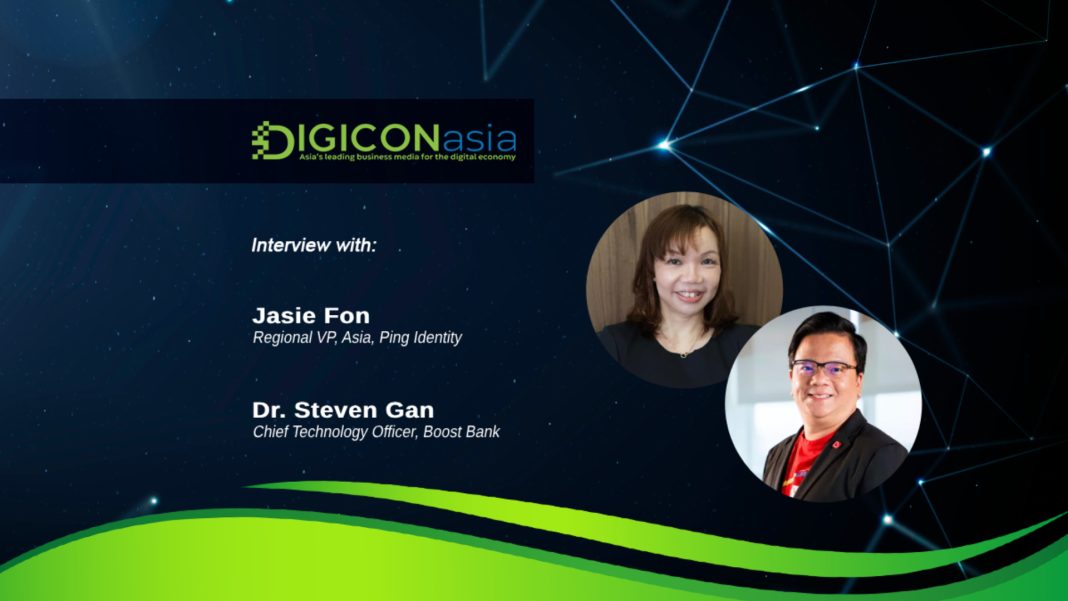As digital technologies become ever more entwined in daily business, identity security has had to swim with the tide amid the rapidly changing currents of cyberthreats. Here’s how an Asian digital bank deals with this new ‘identity crisis’.
Technological advancements – particularly in the field of artificial intelligence (AI) – is perpetuating the dynamism of the current cyber-risk situation, with identity continuing to be a critical focal point for cybersecurity and resilience.
Malaysia’s first digital bank, Boost Bank faced significant challenges in such a landscape. Dr Steven Gan, Chief Technology Officer, Boost Bank and Jasie Fon, Regional VP, Asia, Ping Identity talk about these challenges and how the neobank is overcoming them.
With regards to the Asia region, what are the biggest challenges faced by digital banks and neobanks today?
Jasie Fon: Digital banks have no physical branches, making the digital experience their single point of experience and failure. Digital identity serves as the gateway to this experience. A robust digital experience is crucial for customer retention. A Ping Identity survey reveals that 65% of customers indicated they would switch to another comparable bank if they have a poor digital experience, particularly concerning passwordless authentication.

Additionally, the rise of artificial intelligence (AI) poses significant threats, especially regarding identity. AI is increasingly used by cybercriminals to commit identity fraud through deepfakes and account takeovers, which heightens security concerns for digital banks.
As a new digital bank, what were the challenges Boost Bank needed to resolve?
Dr Steven Gan: Boost Bank faced several key business challenges, including:
Customer acquisition and retention: With established banks already serving daily service requirements in Malaysia, tapping into those markets to attract and retain customers is a significant challenge.
Regulatory compliance: Bank Negara Malaysia enforces stringent financial regulations on digital banks, including maintaining up-to-date support for Android and iOS systems. This poses challenges, especially for underserved segments that may not have access to bank facilities.

Trust and security: As digital banks have no physical branches, the mobile application becomes the sole touchpoint for users. Ensuring security and building trust in this digital-only environment is critical.
Technology infrastructure: Digital banks must ensure their systems are reliable, scalable, and have zero service interruptions since they rely solely on digital platforms for transactions.
Seamless access: Providing seamless access to banking facilities is crucial as it is a key factor in achieving customer satisfaction and retention.
Partnerships and ecosystem integration: Competing with well-established banks, digital banks must find ways to anchor partnerships and integrate into the existing banking ecosystem.
Utilizing data insights: Leveraging data insights to understand customer needs and offer personalized services is essential for staying competitive and enhancing customer experiences.
What were the main requirements from Boost Bank when looking for a solution to resolve these challenges?
Dr Gan: From a technology perspective, Boost Bank strives to deliver reliable, secure, and innovative digital financial services to customers by relying on five key principles. Firstly, ensuring systems can handle growth and provide reliable services is imperative, and this can be done by having a scalable and robust infrastructure in place.
Secondly, Boost Bank prioritizes security and compliance to protect customers’ data and financial assets. Providing an intuitive and feature-rich mobile banking experience enables customers to have a user-friendly and comprehensive mobile banking experience.
Boost Bank is one of the world’s first banks to enable an embedded banking experience for customers.
Boost Bank leverages Ping Identity’s Identity and Access Management (IAM) solutions, including the Advanced Identity Cloud (AIC) solution, and integrates them into internal embedded banking partners seamlessly. Continuously innovating is an important factor in the company’s growth, as demonstrated by the launch of the wallet linking the current account saving account (CASA) with loyalty features, a first-of-its-kind in the market.
Why did Boost Bank choose to work with Ping Identity? How is Ping Identity supporting Boost Bank to address these challenges?
Dr Gan: Boost Bank has chosen to work with Ping Identity primarily for its expertise in identity and access management (IAM) solutions, which is a critical component in ensuring secure and seamless customer interaction with the bank.
Ping Identity’s robust IAM solutions were able to securely manage customer identity authentication across standalone and embedded banking experiences to prevent unauthorized access and fraud.
Boost Bank has enabled Ping Identity’s Single Sign-On (SSO) capability, allowing customers to use a single set of credentials. This reduces the complexity of managing multiple credentials and provides convenience to customers.
Ping Identity helps secure customers’ data and creates a personalized customer experience, contributing to overall confidence, satisfaction, and retention. To date, Boost Bank has successfully acquired and onboarded around 41,000 customers. During the public launch last month, Boost Bank achieved 100% service availability uptime, ensuring a reliable banking experience for customers.
Through Ping Identity’s public and private key integration as well as through the Advanced Identity Cloud (AIC) solution, a user’s login time is now less than two seconds, allowing Boost’s customers to view their entire banking dashboard seamlessly.
Working with Ping Identity enables Boost Bank to comply with Malaysia’s Risk Management in Technology (RMiT) guidelines, the outsourcing policy, and the Personal Data Protection Act (PDPA) in Malaysia. Boost Bank was able to get through and receive the green light from the central bank, which is not an easy process. Previously, the initial challenge was the slow response when logging into the dashboard. Implementing Ping Identity solutions has helped resolve ticket incidents in split seconds, significantly improving response times and overall customer satisfaction.
Do you have the same team or separate teams running cybersecurity, core banking, and app development at Boost Bank?
Dr Gan: As a digital bank, Boost Bank has five key pillars within the organization, which include:
- Product engineering team: This includes solutions architects and the front- and back-end engineers.
- Platform engineering team: This team consists of Development Operations (DevOps), IT Operations (IT Ops), Security Operations (SecOps), and infrastructure architects.
- Project management Office (PMO): This office oversees projects and includes data scientists and engineering teams who handle all data analytics and personalized messaging.
- Security engineering team: This team is the first line of defense against cybersecurity attacks.
- CISO team: The second level of defense is handled by the CISO team, which oversees the organization’s information, cyber, and technology security.
Besides digital banks, what other different solutions do you think digital-driven organizations in our region need today?
Fon: In terms of the importance of being frictionless, it is about finding the balance between security and user convenience. Many companies should review how passwordless authentication comes into play and ensure there is sufficient investment to establish robust policies.
Ping Identity not only focuses on the technology aspect but also enhances other aspects of identity capabilities. For instance, integrating Electronic Know Your Customer (e-KYC) components and exploring the potential of decentralized digital identities allows users to leverage multiple applications without worrying about their credentials being verified.
The overall objective is to enhance identity solutions to improve the customer experience while ensuring security requirements and regulatory compliance.
Dr Gan: Financial organizations should leverage AI. AI has evolved through distinct phases: the first phase involved chatbots, the second phase introduced generative AI (Gen AI), and the third phase envisions AI being integrated everywhere.
Boost Bank is also building an innovation laboratory within the team to embrace banking as a service and offer digital bank services within the internal partner’s ecosystem.



